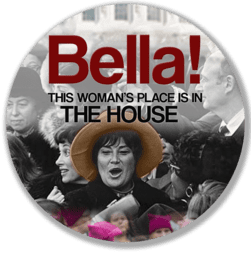Story
Bella's legacy lives on today.
In 1970, Bella Abzug entered Congress ready for a fight. With her trademark hat and Bronx swagger, the first elected Feminist upended the Washington patriarchy, battling for women’s equality, civil rights, and LGBTQ+ protections. Despite Nixon and the FBI’s attempts to silence her, Bella persisted - revolutionizing the blueprint for America.
“Bella was way ahead of her time and the rest of the world had to catch up.” -Barbra Streisand
Act 1
Upon graduating law school, the young Jewish woman fromThe Bronx started her own law practice – prioritizing career, family, and social justice equally. Bella’s activism around McCarthyism and Civil Rights led her to a community of female activists: Women Strike for Peace. Their protests against nuclear proliferation were so effective, they changed laws. That success led to larger ambition. In 1970, Bella launched a campaign for US Congress, representing a large swath of lower Manhattan. Broadway performers lent support, most notably Barbra Streisand, who recalls how Bella easily connected with The Lower East Side’s elderly Jewish voters. That connection dated back to Bella’s childhood synagogue where her Orthodox grandfather taught her the Hebrew prayers. When Bella’s father died suddenly, she was intent on publicly reciting the traditional mourner’s prayer. The elders would not allow it. That did not stop Bella from defying the many sexist norms of her childhood – including making speeches on the subway to collect money for Israel. These interactions became valuable training for the nonstop handshaking of 1970. Many minorities saw their own dreams realized in Bella’s vision, and elected her to victory. Bella headed to Washington, joining only 11 other women in Congress. Her priority was the immediate end of The Vietnam War and she made that very clear to President Nixon. Representative Charles Rangel remembers Bella hit Washington “like a sledgehammer.” Bella says her fearless defiance really erupted in the 1940s upon being told Harvard Law School didn’t admit women. The young working lawyer was dismissed as “just a secretary”, so began wearing her famous hat – a sign of a professional. She proved her ultimate bravery when asked to defend Willie McGee – a black man facing the electric chair in the corrupt courts of the Jim Crow South. Risking her life in pursuit of justice would be a hallmark of her career.
"Bella hit Washington like a sledgehammer."
-Representative Charles Rangel
Act 2
In her first year in Congress, Bella’s fearlessness would be tested immediately, from wearing her hat on the House Floor to challenging DC police on the mass arrest of thousands of anti-war protestors. It was also marked by Bella’s legislative wins for the disabled, public transportation, and a monumental childcare bill that passed the House, but ultimately vetoed by Nixon. With success, Bella suddenly felt the weight of institutional resistance. Her district was re-drawn in a way that made winning again seem impossible. Through a tense street battle that included a defeat, the death of her opponent, and a whole new battle, Bella prevailed, returning to Washington ready for real change. Her trailblazing efforts led to bills granting women credit cards in their own names, and allowing “Ms.” as a valid designation on government documents. She also proposed the first legislation that would grant historic protections to the LGBTQ+ community. Congresswoman Elizabeth Holtzman recalls Bella was way ahead of the times. In her 3rd term, Bella proved herself to be more than an advocate for women, but an advocate for democracy. She became chair of an influential subcommittee and took on the CIA, discovering in the process that they had been spying on her for decades. The front-page news didn’t sidetrack her as she simultaneously helped pass a bill to defund The Vietnam War, bringing it finally to an end. With growing national prominence, Bella set her eyes on running for The US Senate. Her friends said it was career suicide. A grueling year of weekly trips around the state led to strong support and a historic battle against opponent, Daniel Patrick Moynihan, and ultimately, The New York Times. The night of the primary, Bella was in tears as she lost by less than 1%. She ran for mayor of New York City and then Congress once again, and in the end faced three stunning losses in three years. Her once powerful rise came to an abrupt end with many in the press gleefully writing her political obituary.
“I thought it was brilliant of her to move out of being elected and to continue to make a difference in the world and she did.” -Marlo Thomas
Act 3
While she hadn’t begun her political career with a feminist-first agenda, it became clearer to Bella that is where she could make the most impact. She opened the largest gathering of feminists in US history – The National Women’s Conference. Its success led President Jimmy Carter to appoint Bella to lead a presidential advisory committee on women. But only months in, Carter publicly fired Bella. His intention to look bold crumbled as the majority of the committee resigned in solidarity. With sweeping cultural changes in the 1980s led by the election of Ronald Reagan, many women’s groups felt a jolting halt in progressive strides. Bella turned her gaze international to help women in other countries. Effectively teaching policy and how to amend UN resolutions, Bella’s impact was felt globally. A speech at a UN women’s conference in China would be her last, as she ultimately succumbed to the strains of a failing heart in 1998. Speaker Nancy Pelosi reflects that Bella’s legacy lives on today, highlighting the rise of women in Congress: from 12 to 101. But as Hillary Clinton points out, a large number of people do not know Bella’s story, which has the potential to inspire the next little girl from the Bronx to start making speeches on the subway and rise to one day become president.


